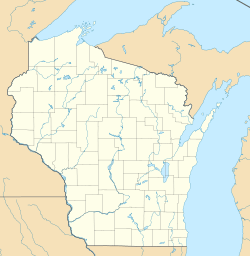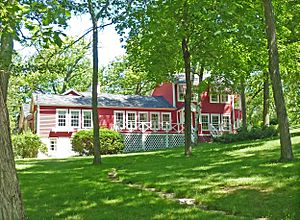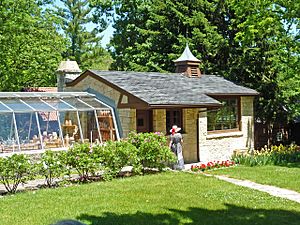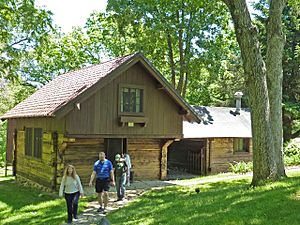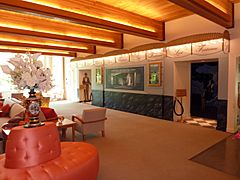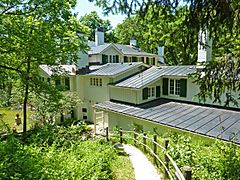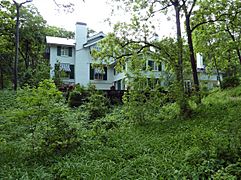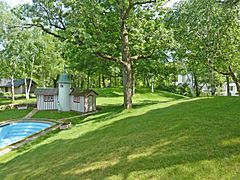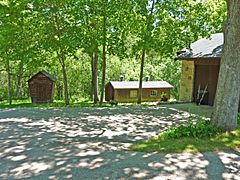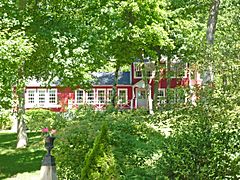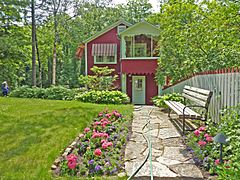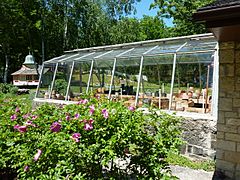Ten Chimneys facts for kids
|
Ten Chimneys
|
|

Entrance to the Main House
|
|
| Location | S42 W31610 Depot Rd., Genesee, Wisconsin |
|---|---|
| Area | 60 acres (24 ha) |
| Built | 1915 |
| Architect | Charles Dornbusch |
| Architectural style | Late 19th And 20th Century Revivals |
| NRHP reference No. | 98000076 |
Quick facts for kids Significant dates |
|
| Added to NRHP | February 23, 1998 |
| Designated NHL | July 31, 2003 |
Ten Chimneys was the special summer home of two famous Broadway actors, Lynn Fontanne and Alfred Lunt. It was also a working farm and a popular meeting place for people in American theater. This unique property is found in Genesee Depot in Waukesha County, Wisconsin, USA.
In 2003, Ten Chimneys was named a National Historic Landmark. This was because of how important its owners were to theater history. It was also recognized for its special buildings and beautiful decorations.
Contents
The Story of Ten Chimneys
Lynn Fontanne's Journey
Lynn Fontanne was born in England in 1887. From a young age, she dreamed of becoming an actress. She started her career in 1905 as a chorus girl in a play called Cinderella. In 1916, she moved to the United States. She became very successful after starring in the play Dulcy in 1921.
Alfred Lunt's Early Life
Alfred Lunt, Jr. was born in 1892 in Milwaukee, Wisconsin. His father was a lumberman. Alfred loved theater from when he was just three years old. He also enjoyed spending summers on his aunt's farm in Neenah.
In 1906, Alfred's stepfather moved the family to Genesee Depot. His stepfather worked there as a doctor. A few years later, the family faced money problems. They had to move to Finland, which was then part of Russia. Alfred spent his summers in Finland and grew to love its culture.
During the school year, he attended Carroll College Academy in Waukesha. He then went to Carroll College, where he studied public speaking. He acted in college plays and even designed and built the scenery. In 1912, he left college to join a theater company in Boston. He became a successful stage actor, earning praise in the play Clarence in 1919.
Building the Summer Home
Even with his successful acting career, Alfred always loved his childhood home in Wisconsin. In 1913, he bought three acres of land near Genesee Depot. This land would later become Ten Chimneys.
In 1915, the first part of the house was built. A visitor described it as "one enormous room" with stairs leading to a gallery. This gallery had doors to bedrooms. Alfred's mother, Hattie, and his half-siblings lived there all year. Alfred joined them during the summers.
Alfred Lunt and Lynn Fontanne met in 1919 during a rehearsal in New York. They fell in love and got married in 1922. Their first summer living with Alfred's mother was a bit difficult. So, in 1924, they decided to turn the chicken coop into a small house for themselves.
This new cottage has many features from old Swedish farmhouses. It has brick and stucco fireplaces with sloped chimneys. There are folk paintings, some painted by Alfred himself. You can also find Swedish writings throughout the cottage. Lynn Fontanne's room upstairs is different. It is all white, with a carpet made of stitched sheepskins.
A Famous Acting Duo
In 1923, Lunt and Fontanne acted in their first play together, Sweet Nell of Old Drury. The next year, they starred in The Guardsman. This play was highly praised, and they later made it into a movie. Over the years, they acted together in more than 140 Broadway plays. They were known as the most important acting couple in American theater.
In 1932, Lunt and Fontanne switched houses with Alfred's mother and sister. The actors moved into the main house, and his mother and sister moved to the Cottage. Alfred then jokingly called the Cottage the "hen house."
Over the years, Lunt and Fontanne kept building and improving Ten Chimneys. In 1936, they added an L-shaped swimming pool and a changing room. In 1938, they started remodeling and expanding the main house. They added rooms for the cook and housekeeper, plus more living space. Alfred worked with architect Charles Dornbusch on the design. Dornbusch had also helped with other buildings on the estate, including the cottage.
In 1939, they added a metal gate around the auto court. By 1947, they finished a new chicken coop and a greenhouse. They also built a gatehouse. In the same year, they rebuilt the Studio. This was a traditional log building that was taken apart in Sweden, shipped to America, and put back together. It was used as a rehearsal space. Later, flagstone paths and stone walls were added to connect everything on the estate.
Inside the Main House
The inside of the main house at Ten Chimneys is truly special. The entry hall has marble tiles and hand-painted pictures on the walls. There is also a beautiful Swedish porcelain stove. A grand spiral staircase leads to the second floor.
On the second floor, you'll find the kitchen and a room the Lunts called the Flirtation Room. This room leads to other parts of the house, like the Music Room. The Music Room has a fireplace and hand-painted pictures showing Bible stories, like baby Moses in the bullrushes. Artist Claggett Wilson started painting these in 1938 when the house was expanded. The library even has a secret passage hidden behind a bookshelf!
The upper floor has bedrooms with paintings of farmers and wildlife. Lynn's bedroom is light-colored and has its own Swedish fireplace. Alfred's bedroom is simpler, also with a Swedish corner fireplace. The many fireplaces in the house are why the estate is called "Ten Chimneys."
Life on the Farm
Ten Chimneys was also a working farm. This might seem surprising for famous actors! As a child, Alfred loved working in the fields, and he continued this as an adult. He once wrote home from England, "I had a high old time as their garden was full of weeds & did I go to it..."
The farm at Ten Chimneys grew from three acres to over 100 acres. Since Alfred was away acting for much of the year, he hired Ben Perkins in 1929 to manage the farm. While Alfred was away, they wrote letters about farm matters, like buying a used silo filler for $65. Alfred was careful with money.
They started a large vegetable garden in 1939 and an orchard later. In 1941, Alfred and Lynn gave each other cows as Christmas gifts. These were the first two cows on the farm. By 1942, the farm had four cows, some pigs, and up to 200 chickens. To feed the animals, they grew corn, oats, alfalfa, clover, and wheat. The milk from the cows was made into butter. Some was eaten on the farm, and some was sold locally. During WWII, some butter, meat, and vegetables were even sent to the Lunts in New York and Europe. This was helpful because food was rationed then.
Alfred once said in 1956, "I'm just a country boy who happens to be an actor. But fashionable parties and clever talk - all that sort of thing - well, y'know, it bores me stiff. I'd rather listen to my chickens clucking any time."
A Retreat for Stars
During their careers, Fontanne and Lunt returned to Ten Chimneys every summer. It was a place for them to relax and get new ideas for their acting. Many famous stage and movie stars visited the Lunts at Genesee Depot. These guests included Noël Coward, Helen Hayes, Orson Welles, Laurence Olivier, and Vivien Leigh. The actress Carol Channing once said, "If you get to go to Ten Chimneys, you must have done something right."
After they retired, the Lunts lived at Ten Chimneys for the rest of their lives. Alfred passed away in 1977, and Lynn in 1983.
Opening to the Public
In 1996, Joseph W. Garton, who loved the arts, bought Ten Chimneys. He then helped create the Ten Chimneys Foundation to protect and share the estate. The foundation bought the property from Garton in 1998.
The estate was very well preserved. The Lunts' original furniture, decorations, and personal items were almost untouched after Lynn Fontanne's death in 1983 until the foundation began its work in 1998.
The Ten Chimneys Foundation opened the estate to the public for the first time on May 26, 2003. This date would have been the Lunts' 81st wedding anniversary. The estate is still open for public tours from May through November. The foundation also continues to support the arts. It provides programs and resources for people who work in theater, just as the Lunts did.
Gallery
See also


